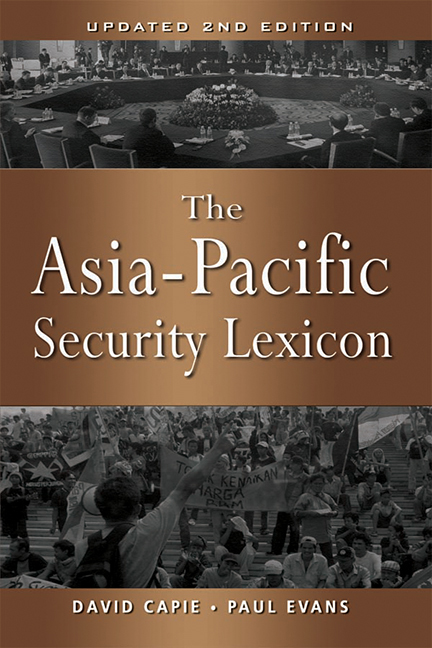Book contents
- Frontmatter
- Contents
- Abbreviations
- Introduction to the Second Edition
- Ad Hoc Multilateralism
- A la Carte Multilateralism
- The “ASEAN Way”
- Balance of Power
- Bilateralism
- Coalition of the Willing
- Coercive Diplomacy
- Collective Defence
- Collective Security
- Common Security
- Comprehensive Security
- Concert of Powers
- Concerted Unilateralism
- Confidence-Building Measures
- Confidence- and Security-Building Measures
- Constructive Intervention
- Cooperative Security
- Engagement
- Flexible Consensus
- Human Security
- Humanitarian Intervention
- Middle Power
- Multilateralism
- Mutual Security
- New Security Approach
- Non-Traditional Security
- Open Regionalism
- Peaceful Rise
- Pre-emption and Preventive War
- Preventive Diplomacy
- Security Community
- Terrorism
- Track One
- Track One-and-a-Half
- Track Two
- Track Three
- Transparency
- Trust-Building Measures
- About the Authors
Collective Defence
Published online by Cambridge University Press: 21 October 2015
- Frontmatter
- Contents
- Abbreviations
- Introduction to the Second Edition
- Ad Hoc Multilateralism
- A la Carte Multilateralism
- The “ASEAN Way”
- Balance of Power
- Bilateralism
- Coalition of the Willing
- Coercive Diplomacy
- Collective Defence
- Collective Security
- Common Security
- Comprehensive Security
- Concert of Powers
- Concerted Unilateralism
- Confidence-Building Measures
- Confidence- and Security-Building Measures
- Constructive Intervention
- Cooperative Security
- Engagement
- Flexible Consensus
- Human Security
- Humanitarian Intervention
- Middle Power
- Multilateralism
- Mutual Security
- New Security Approach
- Non-Traditional Security
- Open Regionalism
- Peaceful Rise
- Pre-emption and Preventive War
- Preventive Diplomacy
- Security Community
- Terrorism
- Track One
- Track One-and-a-Half
- Track Two
- Track Three
- Transparency
- Trust-Building Measures
- About the Authors
Summary
Sometimes called “collective self-defence”. Historically one of the most important elements of states' national security policies, second only to “self-help”. The concept refers to the practice where states agree to collaborate to ward off a threat from an identified enemy (whether actual or potential). This collaboration is usually in the form of alliance relationships, coalitions, or pacts of mutual assistance, which aim to deter the would-be aggressor. The bestknown collective defence arrangements during the Cold War were the North Atlantic Treaty Organization (NATO) and the Warsaw Pact. The “inherent right of individual or collective self-defence” is recognized in Article 51 of the United Nations Charter.
While collective defence is a very simple idea, in practice it is often confused with collective security. This is not surprising, for as well as having similar names they overlap in content. In the case of both collective security and collective defence, states commit themselves to assist others in the event of an attack. In both instances, the victim of aggression expects its defensive strength to be supplemented by the strength and support of other states. However, the essential difference between the two concepts is the way the states conceive of the enemy. According to Arnold Wolfers, nations enter collective defence arrangements to ward off threats to their national security emanating from some “specific country or group of countries regarded as the chief national enemy, actual or potential”. In contrast, collective security arrangements are directed against “any and every country anywhere that commits an act of aggression, allies and friends included”. In other words, while collective defence arrangements are focused against a particular (albeit often unnamed) external enemy, collective security targets aggression itself, from wherever it might come, including from within the group, with the threat of all against one.
The development of the modern series of collective defence agreements in the Asia-Pacific began with the end of World War II.
- Type
- Chapter
- Information
- The Asia-Pacific Security Lexicon (Upated 2nd Edition) , pp. 47 - 52Publisher: ISEAS–Yusof Ishak InstitutePrint publication year: 2007

